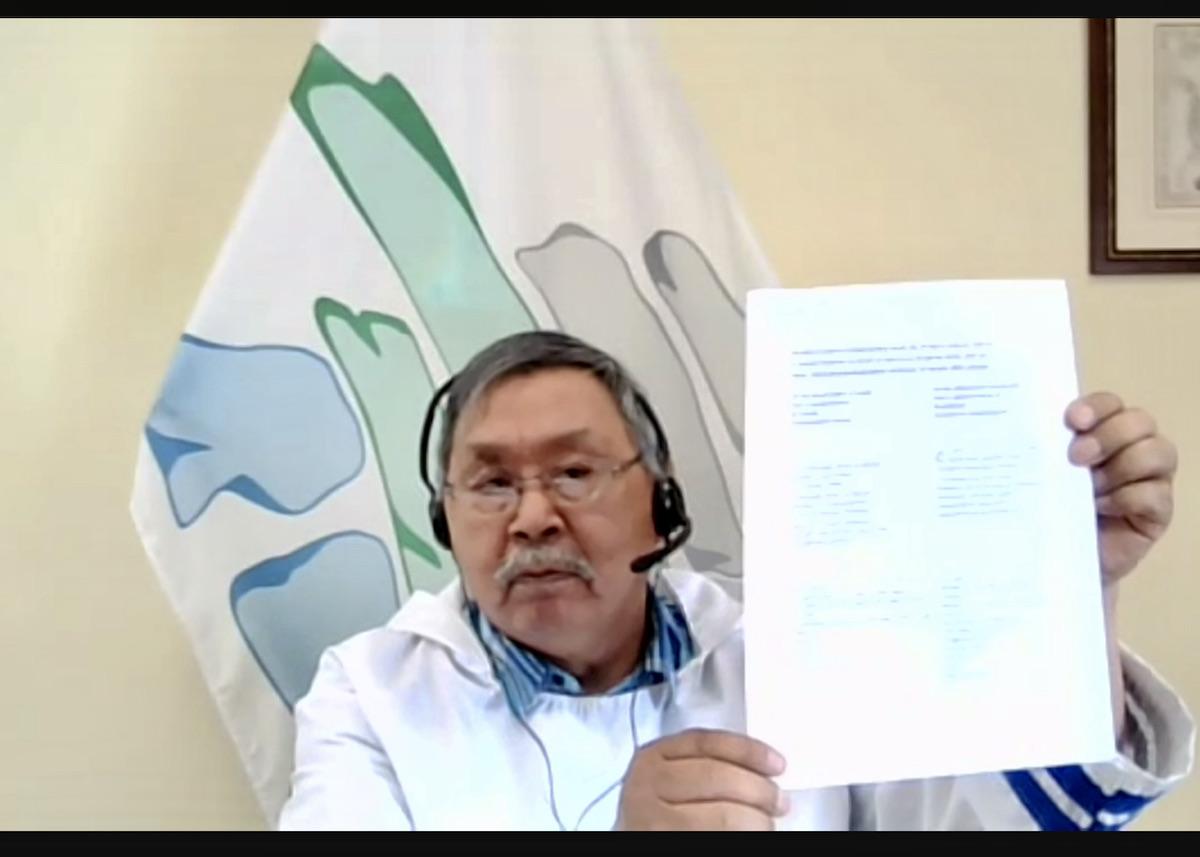
Inuit hunt, fish and travel the waters off Torngat Mountains National Park in Newfoundland and Labrador. This iceberg is in Saglek Bay/Parks Canada
Plans to study the feasibility of a national marine conservation area in the Nunatsiavut area of northern Labrador are moving ahead.
Steven Guilbeault, Minister of Environment and Climate Change and Minister responsible for Parks Canada, and Johannes Lampe, President of Nunatsiavut, virtually signed a Memorandum of Understanding (MOU) last week to study whether the area could be created under the Canada National Marine Conservation Areas Act.
The MOU confirms the proposed study area boundary, assessment topics and planned consultations. It follows the 2017 signing of a Statement of Intent to advance the Imappivut Marine Planning Initiative of the Nunatsiavut Government.

Nunatsiavut President Johannes Lampe (shown) does a virtual signing of a Memorandum of Understanding with Steven Guilbeault, Minister responsible for Parks Canada/Parks Canada
Although Nunatsiavut remains part of Newfoundland and Labrador, its Inuit regional government has authority over many central governance areas including health, education, culture and language.
The study area is 14,906 square kilometres (5,800 square miles) — triple the size of Prince Edward Island — and is in the coastal waters beside Torngat Mountains National Park.
An Indigenous protected area will conserve part of the Labrador Shelf Marine Region, which will increase connectivity and protect the fjords that extend into the park. Beluga whales, seals, breeding and migrating seabirds and waterfowl, and a variety of fish thrive in this region.
“Labrador Inuit culture, knowledge, livelihood and health is directly connected to the ocean,” Lampe said in a news release, calling the signing an important step in managing the waters off the coast. “We look forward to continued progress towards establishing an Indigenous protected area, and in safeguarding Labrador Inuit culture and identity, as well as the fish and animals that we rely on for food.”

The waters off Torngat Mountains National Park may become an Indigenous protected area/Parks Canada
Labrador Inuit have extensive knowledge of the land, water and sea ice in this area and continue to be sustained by its wildlife. Inuit knowledge, coupled with science, will be used as the foundation for the feasibility assessment.
Guilbeault said biodiversity loss and the changing climate are threatening ecosystems across Canada and demand urgent action. “The beautiful yet fragile ocean ecosystems of the northern Labrador coast are no exception.”
Joyce Murray, Minister of Fisheries, Oceans and the Canadian Coast Guard, said oceans are important to Canadians, “especially to coastal and Indigenous communities whose cultures and livelihoods are tightly interwoven with marine ecosystems and species.”
There will be engagement sessions and consultations with Indigenous and local communities and stakeholders, plus consideration of the social, environmental and economic benefits and impacts. If an Indigenous protected area is deemed feasible, an Impacts and Benefits Agreement would be negotiated, in accordance with the provisions of the Labrador Inuit and Nunavik Inuit land claims agreements.
Parks Canada oversees national marine conservation areas. There are two in Ontario, one in Quebec and one in British Columbia.
Northern Labrador is home to the cold offshore Labrador Current, which is famous for carrying icebergs to lower latitudes and mixing with the Gulf Current (Gulf Stream) off the Grand Banks of Newfoundland.
Canada hopes to conserve 25 per cent of its lands and waters by 2025, and 30 per cent of each by 2030. It's working to halt and reverse nature loss.
Meanwhile, the Torngat Mountains Base Camp and Research Station is planning a seven-week visitor season from July 20 to Sept. 7, after closing in 2020 and 2021 due to the pandemic. Tuttuk (Caribou) Adventures run three to seven days and start at $8,400 Canadian ($6,600 USD). Amaguk (Wolf) Adventures also run three to seven days and start at $7,720 Canadian ($6,100 USD).
The remote park boasts 9,700 square kilometres (3,745 square miles) of wilderness stretching from Saglek Fjord to the northern tip of Labrador, and westward from the Atlantic coast to the Quebec border. It’s dangerous polar bear country, and home to mountains, small glaciers, black bears and caribou. The Inuit hunt, fish and travel here in their subarctic homeland.
The base camp hosts international researchers, Inuit elders and youth, and global visitors. It’s inside an electric bear fence and has a range of tent-style accommodations plus local Inuit bear guards/guides. Packages include charter flights between Happy Valley-Goose Bay and Saglek Airstrip, meals and guided excursions to places like Hebron, North Arm, Sallikuluk (Rose Island), Ramah and Nachvak Brook.
The park is accessible only by boat, charter plane or helicopter during the summer. Landing permits are required if flying in. Experienced independent travellers are welcome, although most visitors stay within the base camp for safety. Some expedition cruises, like the Greenland & Wild Labrador route with Adventure Canada, explore the area and might even land at base camp.

 Support Essential Coverage of Essential Places
Support Essential Coverage of Essential Places



